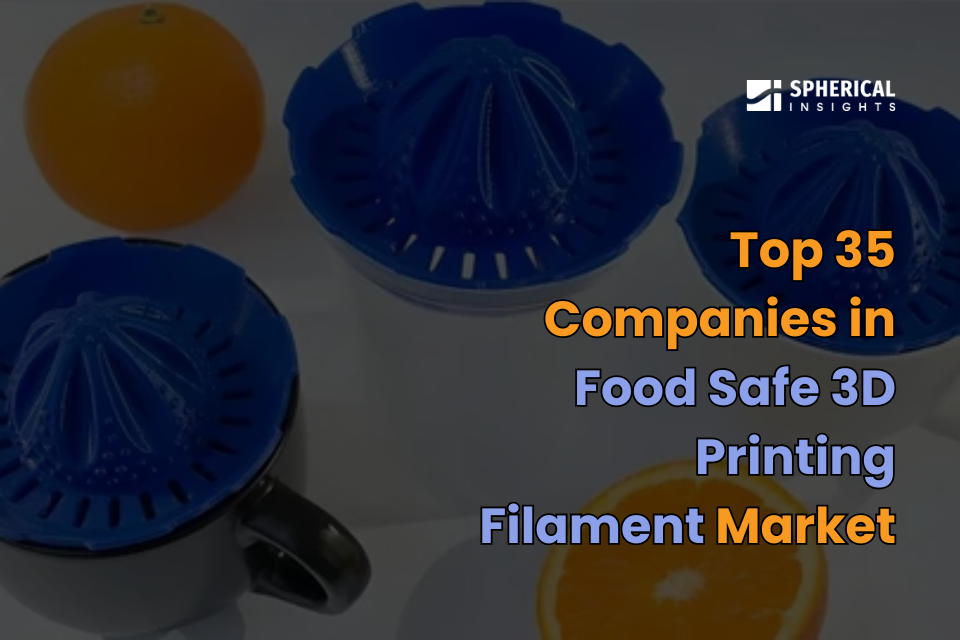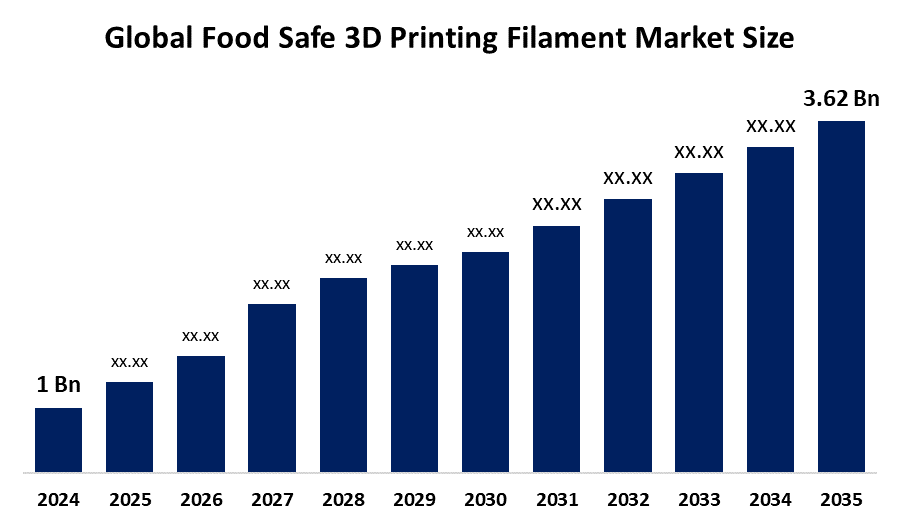
Top 35 Companies in Food Safe 3D Printing Filament Market (2025–2035): Spherical Insights Analysis
RELEASE DATE: Sep 2025 Author: Spherical InsightsRequest Free Sample Speak to Analyst
Description
According to a research report published by Spherical Insights & Consulting, The Global Food Safe 3D Printing Filament Market Size is projected to Grow from USD 1 Billion in 2024 to USD 3.62 Billion by 2035, at a CAGR of 12.41% during the forecast period 2025–2035. The market for food-safe 3D printing filaments is being driven by various factors, including rising demand for customized food packaging and utensils, increasing adoption of 3D printing in the food industry, and advancements in additive manufacturing technologies.
Introduction
The Food-Safe 3D Printing Filament Market Size is described as the creation and distribution of specialized additive manufacturing materials intended for direct or indirect food contact while adhering to rigorous safety rules. These filaments are non-toxic, biocompatible, and approved for food safety requirements, making them ideal for a variety of applications. The increasing use of 3D printing technology in sectors like as food & beverage, consumer products, and healthcare is a major driver of this industry. The growing demand for personalized and creative food-contact goods, such as packaging, utensils, and kitchenware, is fueled by commercial and home-based 3D printing applications. Furthermore, governments and regulatory agencies are imposing more stringent food safety regulations, promoting the use of certified, high-quality products. Advances in 3D printing technology have increased the strength, flexibility, and design possibilities of food-safe filaments, making them more appealing. The global 3D printing filament market, of which food-safe filaments are a niche but critical component, is experiencing tremendous expansion in the automotive, aerospace, and healthcare industries, which is driving demand. The healthcare industry's use of biocompatible filaments for individualized implants and medical equipment exemplifies the market's transformational potential. Overall, it is poised for significant development, fueled by innovation, safety, and sustainability.
Navigate Future Markets with Confidence: Insights from Spherical Insights LLP
The insights presented in this blog are derived from comprehensive market research conducted by Spherical Insights LLP, a trusted advisory partner to leading global enterprises. Backed by in-depth data analysis, expert forecasting, and industry-specific intelligence, our reports empower decision-makers to identify strategic growth opportunities in fast-evolving sectors. Clients seeking detailed market segmentation, competitive landscapes, regional outlooks, and future investment trends will find immense value in the full report. By leveraging our research, businesses can make informed decisions, gain a competitive edge, and stay ahead in the transition toward sustainable and profitable solutions.
Unlock exclusive market insights-Download the Brochure now and dive deeper into the future of the Food Safe 3D Printing Filament Market.
Food Safe 3D Printing Filament Market Size & Statistics
- The Market Size for Food Safe 3D Printing Filament Was Estimated to be worth USD 1 Billion in 2024.
- The Market Size is Going to Expand at a CAGR of 12.41% between 2025 and 2035.
- The Global Food Safe 3D Printing Filament Market Size is anticipated to reach USD 3.62 Billion by 2035.
- North America is expected to generate the highest demand during the forecast period in the Food Safe 3D Printing Filament Market
- Asia Pacific is expected to grow the fastest during the forecast period in the Food Safe 3D Printing Filament Market.

Regional growth and demand
Asia Pacific is expected to grow the fastest during the forecast period in the food safe 3D printing filament market. Asia Pacific is expected to grow the fastest in the food safe 3D printing filament market due to rapid adoption of 3D printing technologies, increasing food industry automation, growing manufacturing capabilities, and rising demand for customized, safe, and innovative food packaging solutions.
North America is expected to generate the highest demand during the forecast period in the Food Safe 3D Printing Filament market. North America is expected to generate the highest demand in the Food Safe 3D Printing Filament market due to advanced food processing industries, high adoption of 3D printing technology, stringent food safety regulations, and strong consumer preference for customized and safe food products.
Top 10 Trends in the Food Safe 3D Printing Filament Market
- Dominance of PLA and PETG
- Emergence of Innovative Materials
- Growth in Key Industries
- Increased Focus on Certifications
- Integration of Printing Technique and Post-Processing
- Demand for Customization
- High-Quality Filament as a Differentiator
- Market Expansion and Growth
- Importance of Material Properties
- Focus on Sustainable Options
1. Dominance of PLA and PETG
PLA (Polylactic Acid) and PETG (Polyethylene Terephthalate Glycol) are still the most popular food-safe 3D printing filaments due to their biodegradability, chemical stability, and simplicity of printing. Their appeal is fueled by constant quality, safety, and compatibility with a wide range of food-contact applications.
2. Emergence of Innovative Materials
ASA (Acrylonitrile Styrene Acrylate) is gaining popularity as a long-lasting, UV-resistant filament ideal for outdoor food-contact applications. Its excellent strength and weather resilience make it a viable option for specific food-safe 3D printing applications.
3. Growth in Key Industries
Specialty filaments, such as composites infused with natural fibers, antibacterial agents, or heat-resistant additives, are increasingly being employed to satisfy specific demands in food packaging, equipment, and utensils, providing greater functionality above regular PLA or PETG.
4. Increased Focus on Certifications
Regulatory compliance and consumer safety promote demand for filaments that are FDA-approved, EU-compliant, or that fulfill other food contact criteria. Certified filaments provide safety, dependability, and market acceptance.
5. Integration of Printing Technique and Post-Processing
Manufacturers are developing high-performance food-safe filaments that have better heat resistance, chemical stability, and mechanical qualities. These materials broaden the use of 3D printing in food processing, packaging, and personalized culinary solutions.
Empower your strategic planning:
Stay informed with the latest industry insights and market trends to identify new opportunities and drive growth in the food safe 3D printing filament market. To explore more in-depth trends, insights, and forecasts, please refer to our detailed report.
Top 25 Companies Leading the Food Safe 3D Printing Filament Market
- ColorFabb BV
- Proto-pasta
- Taulman 3D
- FormFutura
- Hatchbox 3D
- MatterHackers
- 3D Fuel
- Polymaker
- Fillamentum
- Fiberlogy
- eSUN
- Recreus
- Mosaic Manufacturing
- 3D Systems
- Ultimaker
- Raise3D
- Kodak
- XYZprinting
- MakerBot Industries
- Prusa Research
- Copper3D
- Treed
- Filaments.ca
- Extrudr
- 3DJake
1. ColorFabb BV
Headquarters: Belfeld, Netherlands
ColorFabb, based in Belfeld, Netherlands, has an enormous global presence, supplying clients in more than 60 countries. The firm is well-known for its filament technology innovation, with products such as PLA/PHA mixes, metal-filled composites, and lightweight PLA available to meet a wide range of 3D printing requirements. ColorFabb's materials are highly recognized in the food-safe 3D printing filament industry for making bespoke packaging, utensils, and other applications requiring safety and performance. ColorFabb has established itself as a pioneer in providing dependable and sophisticated printing solutions by emphasizing quality, continual innovation, and adherence to international safety requirements.
2. Proto-pasta
Headquarters: Vancouver, Washington, USA
Proto-pasta, based in Vancouver, Washington, USA, has developed its global reach through distribution networks and regional offices on many continents. The firm is known for its inventiveness and technological competence, and it manufactures unique filaments such as carbon-fiber reinforced PLA, stainless-steel infused PLA, conductive filaments, and aromatic versions. These unique materials meet both functional and aesthetic requirements, enabling improved applications in the food-safe 3D printing filament industry, notably in bespoke molds and long-lasting food-contact equipment. With a reputation for precise production and inventive product development, Proto-pasta has established itself as a reliable provider of high-performance solutions for specialist 3D printing needs.
3. TAULMAN3D
Headquarters: Linton, Indiana, USA
Taulman3D, located in Linton, Indiana, USA, has a global distribution network that includes six continents. The firm is well-known for producing high-performance materials, such as nylon, PET, and PETG filaments, which are appreciated for their strength, chemical resistance, and longevity. Taulman3D's solutions are especially well-suited for applications in packaging, cutlery, and industrial kitchen equipment where safety and dependability are vital. Taulman3D is a reliable provider in the additive manufacturing business, with a focus on advanced material research and worldwide accessibility.
4. FormFutura
Headquarters: Nijmegen, Netherlands
FormFutura, based in Nijmegen, Netherlands, covers over 75 countries through a large network of distributors and resellers. The firm is known for its commitment to sustainability, providing a diverse range of bio-based and recycled filaments such as Premium PLA, BioFil wood, and ASA flame-retardant versions. Many of its products are intended to fulfill food-contact safety regulations, making them perfect for environmentally friendly uses in the food-safe 3D printing filament sector. FormFutura has established itself as a global leader in sustainable 3D printing because of its unique ReFill technology, which lowers packaging waste, and its dedication to manufacturing safe, high-quality materials.
5. Hatchbox 3D
Headquarters: California, USA
Hatchbox, located in California, USA, is one of the most prominent firms in the consumer 3D printing sector, having a strong presence in North America and expanding into Europe. The firm is recognized for creating dependable, inexpensive, and widely available filaments such as PLA, ABS, and PETG, which are popular among enthusiasts and professionals alike. While Hatchbox does not primarily focus on specialist or certified food-safe materials, its products are frequently utilized in basic food-contact applications due to their consistency and ease of use. Hatchbox's excellent brand awareness and large client base make it a dominating player in mainstream 3D printing.
Are you ready to discover more about the food-safe 3D printing filament market?
The report provides an in-depth analysis of the leading companies operating in the global food-safe 3D printing filament market. It includes a comparative assessment based on their product portfolios, business overviews, geographical footprint, strategic initiatives, market segment share, and SWOT analysis. Each company is profiled using a standardized format that includes:
Company Profiles
- ColorFabb BV
- Business Overview
- Company Snapshot
- Products Overview
- Company Market Share Analysis
- Company Coverage Portfolio
- Financial Analysis
- Recent Developments
- Merger and Acquisitions
- SWOT Analysis
- Proto-pasta
- TAULMAN3D
- FormFutura
- Hatchbox 3D
- MatterHackers
- 3D Fuel
- Polymaker
- Fillamentum
- Others.
Conclusion
The Global Food-Safe 3D Printing Filament Market Size is expanding rapidly, driven by increased demand for personalized, safe, and sustainable solutions in areas such as food packaging, kitchenware, and healthcare. Growing consumer awareness of food safety standards, along with regulatory emphasis on certified and non-toxic products, accelerates market acceptance. PLA, PETG, and specialized filaments are driving innovation, while certified high-performance choices continue to broaden applications. With Asia Pacific emerging as the fastest-growing region and North America driving strong demand, the market is positioned for consistent growth, aided by ongoing material improvements and expanding international acceptance.
About the Spherical Insights & Consulting
Spherical Insights & Consulting is a market research and consulting firm which provides actionable market research study, quantitative forecasting and trends analysis provides forward-looking insight especially designed for decision makers and aids ROI.
Which is catering to different industry such as financial sectors, industrial sectors, government organizations, universities, non-profits and corporations. The company's mission is to work with businesses to achieve business objectives and maintain strategic improvements.
CONTACT US:
For More Information on Your Target Market, Please Contact Us Below:
Phone: +1 303 800 4326 (the U.S.)
Phone: +91 90289 24100 (APAC)
Email: inquiry@sphericalinsights.com, sales@sphericalinsights.com
Contact Us: https://www.sphericalinsights.com/contact-us
Need help to buy this report?